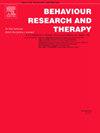Dual-task interventions reduce vividness and unpleasantness in both old and new memories
IF 4.5
2区 心理学
Q1 PSYCHOLOGY, CLINICAL
引用次数: 0
Abstract
A core element of EMDR therapy is that a patient recalls a traumatic memory while concurrently making horizontal eye movements. Experimental studies show that performing such tasks simultaneously (i.e., Recall + Dual-Task) reduces the memory's vividness and unpleasantness. Memory age may act as a boundary condition on this effect as older memories have been more consolidated and strengthened over time compared to more recently formed memories, making older memories less susceptible to change. To investigate this, participants (N = 195) in Experiment 1 recalled an old or a new negative autobiographical memory and were randomly assigned to a Recall + Dual-Task intervention or a Recall Only intervention. Before, during, and after the intervention the memory was rated on vividness and unpleasantness. In Experiment 2 (N = 356) a follow-up rating was added one day later to test for delayed effects of memory age on intervention effectiveness. Collectively, the two experiments show that Recall + Dual-Task immediately reduces memory vividness and unpleasantness compared to Recall Only. For unpleasantness this differential effect remained one day later. However, none of the effects were moderated by memory age. Thus, these findings suggest that memory age is not a boundary condition for dual-task effectiveness and that dual-task interventions (as used in EMDR) could be similarly effective for reducing the intensity of emotional memories of different ages.
双重任务干预减少了新旧记忆中的生动和不愉快
EMDR治疗的一个核心要素是患者在回忆创伤记忆的同时进行水平眼动。实验研究表明,同时执行这些任务(即回忆+双重任务)可以减少记忆的生动性和不愉快性。记忆年龄可能是这一效应的一个边界条件,因为随着时间的推移,较老的记忆比较新形成的记忆更加巩固和加强,使较老的记忆不太容易改变。为了研究这一点,实验1的参与者(N = 195)回忆了一个旧的或新的负面自传体记忆,并被随机分配到回忆+双任务干预或仅回忆干预。在干预之前、期间和之后,对记忆的生动程度和不愉快程度进行了评分。实验2 (N = 356)在一天后增加随访评分,检验记忆年龄对干预效果的延迟效应。总的来说,这两个实验表明,与仅回忆相比,回忆+双重任务能立即减少记忆的生动度和不愉快度。对于不愉快,这种差别效应在一天后仍然存在。然而,这些影响都不会因记忆年龄而减弱。因此,这些发现表明,记忆年龄不是双任务有效性的边界条件,双任务干预(如EMDR中使用的)对于降低不同年龄的情绪记忆强度可能同样有效。
本文章由计算机程序翻译,如有差异,请以英文原文为准。
求助全文
约1分钟内获得全文
求助全文
来源期刊

Behaviour Research and Therapy
PSYCHOLOGY, CLINICAL-
CiteScore
7.50
自引率
7.30%
发文量
148
期刊介绍:
The major focus of Behaviour Research and Therapy is an experimental psychopathology approach to understanding emotional and behavioral disorders and their prevention and treatment, using cognitive, behavioral, and psychophysiological (including neural) methods and models. This includes laboratory-based experimental studies with healthy, at risk and subclinical individuals that inform clinical application as well as studies with clinically severe samples. The following types of submissions are encouraged: theoretical reviews of mechanisms that contribute to psychopathology and that offer new treatment targets; tests of novel, mechanistically focused psychological interventions, especially ones that include theory-driven or experimentally-derived predictors, moderators and mediators; and innovations in dissemination and implementation of evidence-based practices into clinical practice in psychology and associated fields, especially those that target underlying mechanisms or focus on novel approaches to treatment delivery. In addition to traditional psychological disorders, the scope of the journal includes behavioural medicine (e.g., chronic pain). The journal will not consider manuscripts dealing primarily with measurement, psychometric analyses, and personality assessment.
 求助内容:
求助内容: 应助结果提醒方式:
应助结果提醒方式:


